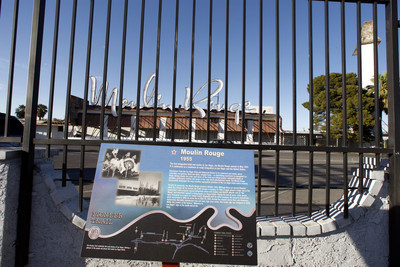Moulin Rouge gets another go

Owners of the site where entertainers like Sammy Davis Jr., Frank Sinatra and Harry Belafonte basked in the vibe of the first integrated casino in Las Vegas say they are poised to revive the soul of that historic spot.
Dale Scott, president and CEO of the Moulin Rouge Development Corp., said he expects to begin demolishing vacant, dilapidated buildings along Bonanza Road within 60 days and submit plans for a new Moulin Rouge resort to the Las Vegas Planning Commission by year’s end.
If he succeeds in redeveloping the 15-acre site, it would mark the reversal of a run of unstable ownership, bankruptcy, deterioration and vacancy that’s plagued the former Moulin Rouge site for more than 50 years.
It would also result in a resort at an unlikely location in a part of downtown Las Vegas that has copious amounts of litter and vagrancy but very few storefronts and almost no attractions for tourists except for a modest sidewalk marker that notes the Moulin Rouge’s significance in Las Vegas’ history.
Scott, 46, a retired Air Force master sergeant who bought into the site in 2004, has yet to reveal who would finance the project, although he says they are from outside Las Vegas.
He did, however, say the company’s vision is to create a hotel-casino with a 750-room hotel, more than 100,000 square feet of gaming and upscale amenities that would attract local and tourist traffic.
“It is going to be an actual hotel-casino, kind of an updated version of what it was yesterday,” said Alan Glover, marketing director for the Moulin Rouge company.
It’s not the first time Scott and his business partners have raised hopes for a revival of the bygone casino. In 2004, shortly after taking over the property in the wake of a fire that destroyed the original structure the previous year, Scott described plans for a 40,000-square-foot casino, a 500-room hotel, a Motown Café and a community center. Later that year he scaled down the plans.
The most tangible change on the site in recent years included closing a short-term apartment building, boarding up the windows and painting the structure purple with gold trim.
The front of the property is now protected by decorative steel gates and the sides are lined with chain-link fencing topped by curls of razor wire.
It wasn’t always so.
The Moulin Rouge opened in 1955 as an integrated casino-hotel in a community that had been referred to as the “Mississippi of the West,” because of a reputation for segregation and bigotry.
Despite the hostile social climate in Las Vegas the Moulin Rouge quickly became a hot spot that attracted crowds from the Strip to its after-hours club where artists like Sinatra gave impromptu performances. Other performers at the Moulin Rouge included the Platters, Count Basie, George Burns and Gregory Hines.
Just six months after opening, the Moulin Rouge closed under suspicious circumstances. It reopened in 1960 and served as a hub for activists who helped negotiate an end to segregation in the downtown and Strip casinos.
The ensuing and perpetual decline of the site has been interrupted sporadically with hopes for a revival and it was added to the National Register of Historic Places in 1992. But so far none of the proposals have ever made it off the drawing board.
Las Vegas casino historians, enthusiasts and researchers have said the site’s distance from other downtown casinos and the overall condition of the neighborhood work against any revival of the property.
“It’s in a low-income area, which makes it tough for something that elaborate to make it,” historian Michael Green said in 2004. “It’s not that it is in a jinxed location, I hope, but the history almost reads that way.”
Contact reporter Ben Spillman at bspillman@reviewjournal.com or (702) 477-3861.












